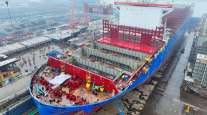Bloomberg News
Biden’s Biggest-Ever Investment Plan for US Still Trails China

[Ensure you have all the info you need in these unprecedented times. Subscribe now.]
What President Joe Biden touted as a historic U.S. federal investment program that will position the country to win the global innovation race still leaves it well behind China’s continuing, giant infrastructure upgrading campaign.
While the top-line for Biden’s American Jobs Plan is $2.25 trillion, China’s government and private companies pour the equivalent of trillions of dollars each year into new infrastructure ranging from transport to communications networks, water projects to manufacturing.
If spread evenly over the eight-year time frame, Biden’s plan would be a little more than $280 billion a year. By comparison, in China, just one source of public funds used mainly for infrastructure investment — local government “special” bonds — will total 3.65 trillion yuan ($556 billion) this year.
RELATED: 'Chargers Everywhere': Biden Maps $174 Billion Path for EV Boom
Looking purely at research and development, China’s is currently second in the world behind the U.S. in terms of annual investment, but is aiming to increase total spending by private companies and state agencies to 3.76 trillion yuan in 2025, the government said last month. That would be 1.3 trillion yuan more than the amount spent last year.
Biden’s program includes $180 billion of government funding for R&D. According to Biden. that is the biggest increase in such spending outside of defense on record, but some question whether it is enough.
“That doesn’t sound like catching up to me,” Jared Woodard, head of Bank of America’s research investment committee, said on Bloomberg TV on April 1.
| "American Jobs Plan" | China's Annual Spending |
|---|---|
| $620 billion for transportation ($77.5 billion a year) |
Transport investment 2020: 3.4 trillion yuan ($522 billion) |
|
$650 billion for cleaner water, |
Telecoms 2020: 407 billion yuan ($62 billion) Water conservation 2020: 770 billion yuan ($117 billion) |
| $50 billion for domestic semiconductor manufacturing |
State-owned semiconductor plan: As much as 200 billion yuan ($30.5 billion) |
| $40 billion upgrading research capacity in laboratories |
China added spending on basic research 2019-2020 14 billion yuan ($2.1 billion) |
However, it’s difficult to directly compare spending in the two countries, as much of China’s outlays are tied to accommodating the millions of rural residents who move to cities for the first time each year.
China’s economic output per capita is about a sixth of U.S. levels, and in many cases the country is for the first time building infrastructure such as urban apartments, water treatment systems and airports that the U.S. has had for generations.
“China is a developing country, and the area for investment in infrastructure is larger than in a developed country,” said Justin Lin, a former chief economist at the World Bank who also advises China’s government. “In the U.S., they have the infrastructure, but it might be old and needs to be improved. So the scope for investment in high-income countries is lower.”
But in other cases, such as high-speed rail, China’s infrastructure already is more advanced than America’s — the Asian country’s high speed rail network was almost 38,000 kilometers (24,000 miles) last year. Building also is cheaper in China, so the spending goes further. For example, the construction cost of the Chinese high-speed rail network is about two-thirds of the cost in other countries, according to a 2019 World Bank study.
Biden’s plan likely will be reshaped significantly in Congress, and take months to pass. Advocates say the increasing focus in Washington on competing with China will usher a step-up in innovation and research that goes beyond the proposed federal spending, with incentives that spur private companies to step up as well.
“This is the largest play I’ve seen in my economic career to on-shore industries, to build up nascent industries, to grab global market share in areas where we could beat our competitors” Jared Bernstein, a member of the White House Council of Economic Advisers, said in a Bloomberg TV interview April 1.
Want more news? Listen to today's daily briefing below or go here for more info:




